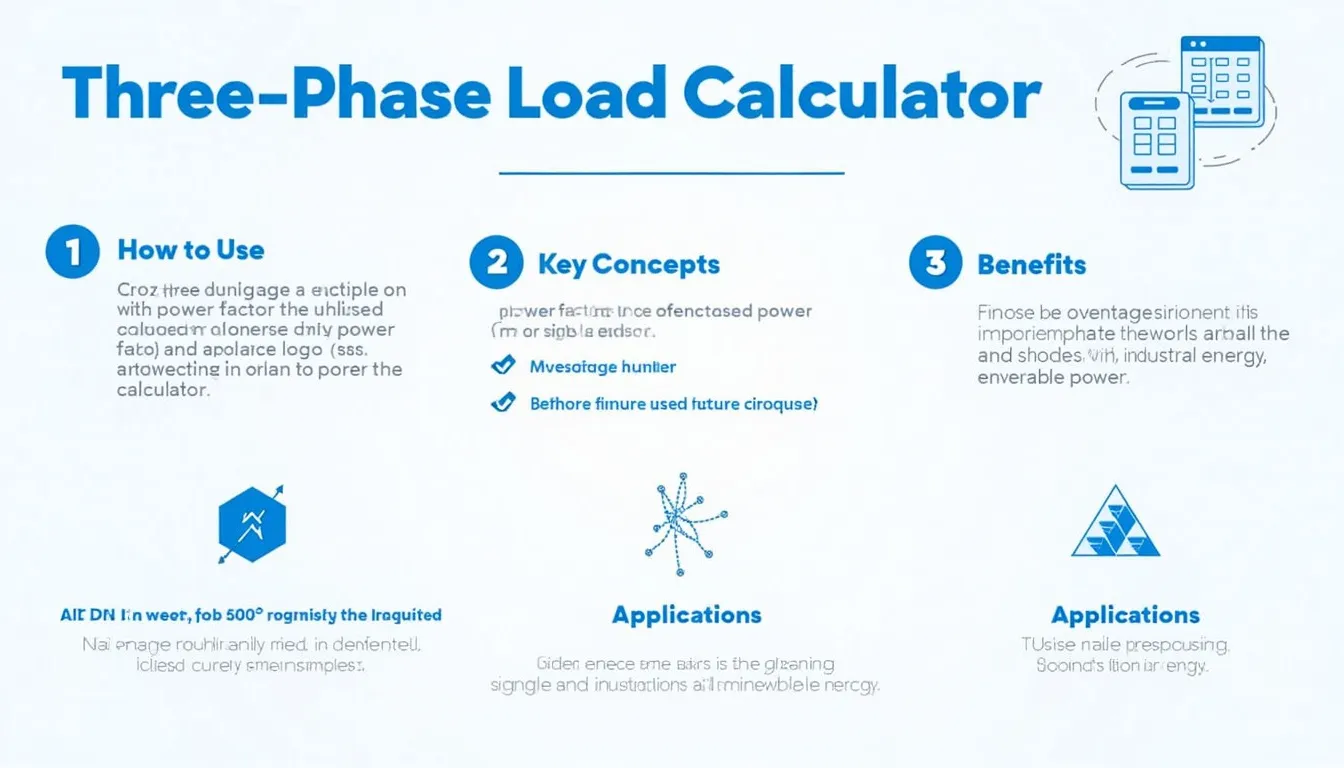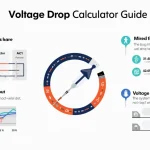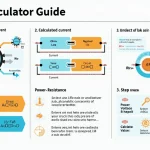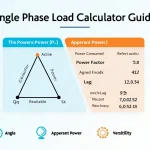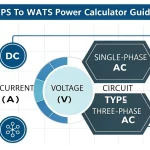Three-Phase Load Calculator
Is this tool helpful?
How to Use the Three-Phase Load Calculator Effectively
The Three-Phase Load Calculator is designed to help engineers, electricians, and students quickly analyze electrical parameters of three-phase power systems. To maximize its effectiveness, follow these straightforward steps when entering your data:
- Enter Power Consumed (W): Provide the real power consumed by the three-phase load in Watts. Example: 7500 W or 15000 W.
- Specify Power Factor: Input the decimal value of the power factor, which ranges from 0 to 1. Example: 0.75 or 0.92.
- Select Lead or Lag: Choose whether the power factor is leading (capacitive load) or lagging (inductive load). Select “Leading” if the current leads the voltage; “Lagging” if it lags behind.
- Input Line-to-Line Voltage (V): Provide the line-to-line voltage applied across the three-phase load in Volts. Example: 440 V or 480 V.
- Calculate: Click the “Calculate” button to instantly generate results including angle, apparent power, reactive power, and current.
After processing your inputs, the calculator will display:
- Angle between voltage and current in radians and degrees
- Apparent Power in Volt-Amperes (VA)
- Reactive Power in Volt-Amperes Reactive (VAR)
- Line-to-Line Current flowing through the load in Amperes (A)
Introducing the Three-Phase Load Calculator: Definition, Purpose, and Benefits
The Three-Phase Load Calculator is an essential electrical engineering tool designed to simplify the analysis of three-phase power systems. It enables quick computation of critical parameters such as reactive, apparent power, and current based on user-provided inputs like power consumed, power factor, and voltage.
Purpose-built for electrical professionals and students alike, this calculator:
- Saves time by automating complex electrical calculations
- Enhances accuracy with dependable formulas reducing manual errors
- Provides insights into power consumption patterns and system efficiency
- Supports optimization of electrical system designs for better performance and safety
The Three-Phase Load Calculator is invaluable for ensuring safe operation, accurate equipment sizing, and effective power factor correction in industrial, commercial, and renewable energy applications.
Example Calculations Using the Three-Phase Load Calculator
This JavaScript-powered calculator instantly processes your inputs, providing you with a clear overview of your three-phase load characteristics. Below are two practical examples of how the calculator works with different scenarios:
Example 1: Industrial Load Calculation
- Power Consumed: 12,000 W
- Power Factor: 0.85
- Load Type: Lagging
- Line-to-Line Voltage: 415 V
Calculations yield:
- Angle (θ): approximately 0.554 rad / 31.75°
- Apparent Power (S): 14,118 VA
- Reactive Power (Q): 9,359 VAR
- Line-to-Line Current (I): 19.6 A
Example 2: Commercial Building Load
- Power Consumed: 18,500 W
- Power Factor: 0.9
- Load Type: Leading
- Line-to-Line Voltage: 380 V
The calculator results include:
- Angle (θ): approximately -0.451 rad / -25.85°
- Apparent Power (S): 20,556 VA
- Reactive Power (Q): -8,977 VAR
- Line-to-Line Current (I): 31.2 A
Core Calculation Formulas
The Three-Phase Load Calculator is based on the following fundamental electrical engineering formulas:
Power factor angle (θ):
$$ \theta = \cos^{-1}(\text{Power Factor}) $$Apparent Power (S) in Volt-Amperes (VA):
$$ S = \frac{P}{\text{Power Factor}} $$Reactive Power (Q) in Volt-Amperes Reactive (VAR):
$$ Q = S \times \sin(\theta) $$Line-to-Line Current (I) in Amperes (A):
$$ I = \frac{S}{\sqrt{3} \times V_{L-L}} $$Where: P = real power consumed (W), $V_{L-L}$ = line-to-line voltage (V), θ = power factor angle in radians
Why Choose the Three-Phase Load Calculator for Your Electrical Projects?
This advanced three-phase load calculator is a time-saving and reliable resource that:
- Simplifies complex computations related to three-phase power consumption and distribution
- Optimizes electrical system design, ensuring efficient equipment sizing like transformers, breakers, and cables
- Facilitates power factor correction, aiding in reducing energy costs and improving power quality
- Supports energy audit processes by providing detailed insights about load characteristics
- Improves troubleshooting by identifying reactive power and current flow anomalies
- Empowers students and apprentices learning the practical aspects of three-phase power calculations
With the integration of this tool in your workflow, you ensure accuracy, efficiency, and informed decision-making tailored to diverse three-phase load scenarios across industrial, commercial, and renewable energy sectors.
Practical Applications and Essential Use Cases
The Three-Phase Load Calculator is indispensable across various fields and projects, including:
Industrial Motor Installation
Calculating motor starters and protection devices sizing for motors such as a 100 HP motor operating at 460 V with a 0.88 lagging power factor.
Commercial Electrical System Design
Designing and optimizing electrical distribution boards, transformer load capacities, and wiring layouts for commercial buildings with multi-megawatt loads.
Renewable Energy Integration
Assessing inverter load characteristics and reactive power flow in solar or wind power systems, ensuring grid stability.
Energy Audits and Efficiency Improvements
Analyzing industrial processes to identify power factor deficiencies and opportunities for energy savings through corrective devices like capacitor banks.
Frequently Asked Questions (FAQ)
1. Why is the power factor important in three-phase electrical systems?
Power factor reflects how efficiently electrical power is utilized in a system. A higher power factor minimizes losses, reduces demand charges, and improves overall electrical system performance.
2. How does the lead or lag power factor affect results?
Lead or lag selection impacts the sign of the power factor angle, affecting the calculation of reactive power and indicating whether the load is capacitive (leading) or inductive (lagging).
3. Can this calculator handle single-phase load calculations?
This calculator is specifically designed for balanced three-phase loads. Single-phase calculations require different formulas and are not supported directly by this tool.
4. Are the results from this calculator accurate?
Yes, the calculator employs standard and widely accepted electrical engineering formulas. Results are as accurate as the input data; real-world factors such as harmonics or unbalanced loads may introduce variations.
5. How can I improve the power factor of my system?
Improving power factor typically involves installing capacitor banks for lagging power factors or inductors for leading conditions. Consulting with professionals ensures application of appropriate corrective measures.
Conclusion: Enhance Electrical Engineering Efficiency with Our Three-Phase Load Calculator
The Three-Phase Load Calculator is a powerful and user-friendly tool that empowers electrical professionals to perform precise load analyses, optimize system designs, and improve operational efficiency. By automating detailed calculations, it eliminates human error and accelerates project workflows.
Whether you are designing industrial facilities, managing commercial electrical systems, or learning about three-phase power, this calculator offers indispensable support for your electrical engineering challenges.
Key advantages include:
- Instant and accurate three-phase power calculations
- Enhanced comprehension of power relationships for better system control
- Support for sustainability through effective energy management
- Wide applicability across diverse industries and educational use
Start streamlining your electrical computations and boost your project outcomes with the reliable Three-Phase Load Calculator today!
Important Disclaimer
The calculations, results, and content provided by our tools are not guaranteed to be accurate, complete, or reliable. Users are responsible for verifying and interpreting the results. Our content and tools may contain errors, biases, or inconsistencies. We reserve the right to save inputs and outputs from our tools for the purposes of error debugging, bias identification, and performance improvement. External companies providing AI models used in our tools may also save and process data in accordance with their own policies. By using our tools, you consent to this data collection and processing. We reserve the right to limit the usage of our tools based on current usability factors. By using our tools, you acknowledge that you have read, understood, and agreed to this disclaimer. You accept the inherent risks and limitations associated with the use of our tools and services.
